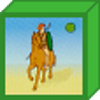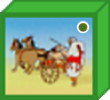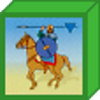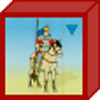Historical Background
In 54 BC, Caesar launched a second invasion of Britain which was better planned and far more formidable than the first one. The invasion force consisted of five legions, auxiliaries, and 2000 cavalry, transported on 800 vessels. The Britons, awed by the size of the fleet, retired inland. This time the landing (near Sandwich) was unopposed. As Caesar moved inland, he encountered a delaying force of Briton charioteers and cavalry in front of the River Stour. The Romans found it difficult to come to grips with the elusive Britons at first, but in time they drove them back. The Roman cavalry played a key role in bringing the British chariots to battle. Post Battle: After retreating across the Stour, the tribal forces joined the rest of the Britons at an oppidum near Bigbury. Caesar promptly crossed the Stour, stormed, and captured, this fortified position.
The stage is set. The battle lines are drawn and you are in command. The rest is history.

 |  |  |  | ||||||||||||||||
| 2 | 7 | 2 | 1 | ||||||||||||||||
 |  |  |  |  | |||||||||||||||
| 2 | 2 | 5 | 2 | 3 |
War Council
Roman Army
• Leader: Caesar
• 6 Command Cards ![]()
![]()
![]()
![]()
![]()
![]()
Victory
6 Banners
Special Rules
• The entire River Stour is fordable.
• Barbarian Chariot Rule is in effect.
• Julius Caesar Rule is in effect.
• Marius Legions Rule is in effect.
